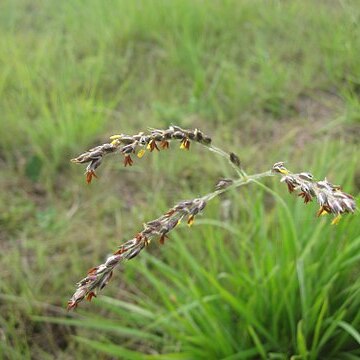Perennial, tussocky from a short rhizome. Culms slender, erect, 30–70 cm, nodes bearded. Basal leaf sheaths persistent, densely and conspicuously silky hairy; leaf blades linear, flat or convolute, stiff, 10–50 × 0.1–1 cm, abaxial surface glabrous, adaxial surface sparsely to densely hairy, base narrow; ligule membranous, ca. 1 mm. Inflorescence digitate; racemes 2–4, 4–12 cm, narrowly ascending, rachis pilose, spikelets grouped on pedicels of varying length. Spikelets lanceolate, 5–6 mm, pale to dark brown, sometimes with transverse banding; glumes sharply acute to shortly awned; lower glume ovate; upper glume margins ciliate, occasionally winged; lower lemma with a small palea corresponding to a thin triangular basal patch on the lemma; upper lemma ovate-lanceolate, ca. 4 mm, smooth, with a rigid 2–3 mm awn-point. Anthers orange, ca. 3 mm. Fl. and fr. Feb–Aug. 2n = 18.
Tufted perennial, the basal sheaths silky pubescent to tomentose and often bulbously thickened; culms 20–150 cm. high.. Leaf-blades linear to convolute, 10–50 cm. long, 1–10 mm. wide.. Inflorescence of 2–4(–8) racemes, digitate; racemes 2–22 cm. long, usually with spikelets all along but sometimes bare at the base.. Spikelets narrowly ovate, 4–7.5 mm. long; straw-coloured to dark purple or sometimes with dark transverse bars; lower glume 1/2–3/4 as long as the spikelet; upper glume acuminate, membranous, appressed ciliate on the margins, occasionally also with membranous wings; upper lemma with an awn 1.5–3 mm. long, the palea sparsely pubescent with linear or clavellate hairs, rarely glabrous.
Non-kranz specimens occur in southern Africa, and Gibbs-Russell (Bothalia 14: 205–213 (1983)) has shown that they can be distinguished morphologically with reasonable certainty, though further study is needed to determine the full range of morphological and anatomical variation.
A. semialata is a polymorphic species unique in possessing both kranz and non-kranz leaf anatomy, the latter generally of an unusual intermediate type (Ellis in S. Afr. Journ. Sci. 70: 169–173 (1974) & in Bothalia 11:273–275 (1974)).
Inflorescence of 2–4(8) racemes, digitate; racemes 2–25 cm. long, usually with spikelets all along but sometimes bare towards the base.
It is therefore of interest for studies on the origin of anatomical variants and the associated differences in photosynthetic pathway.
Superior glume membranous, appressed ciliate on the margins and occasionally expanded laterally into membranous wings, acuminate.
Superior lemma with an awn 1.5–3 mm. long, its palea glabrous or sparsely pubescent with turgid hairs.
Tufted perennial, the basal sheaths silky pubescent to tomentose and often bulbously thickened.
Spikelets 4–7.5 mm. long, sometimes with transverse purple bars.
Leaf laminae 1–12 mm. wide, broadly linear to convolute.
The bulk of the species has kranz anatomy.
Tufted perennial 60–90 cm. high
Culms 20–150 cm. high.
Erect culms

